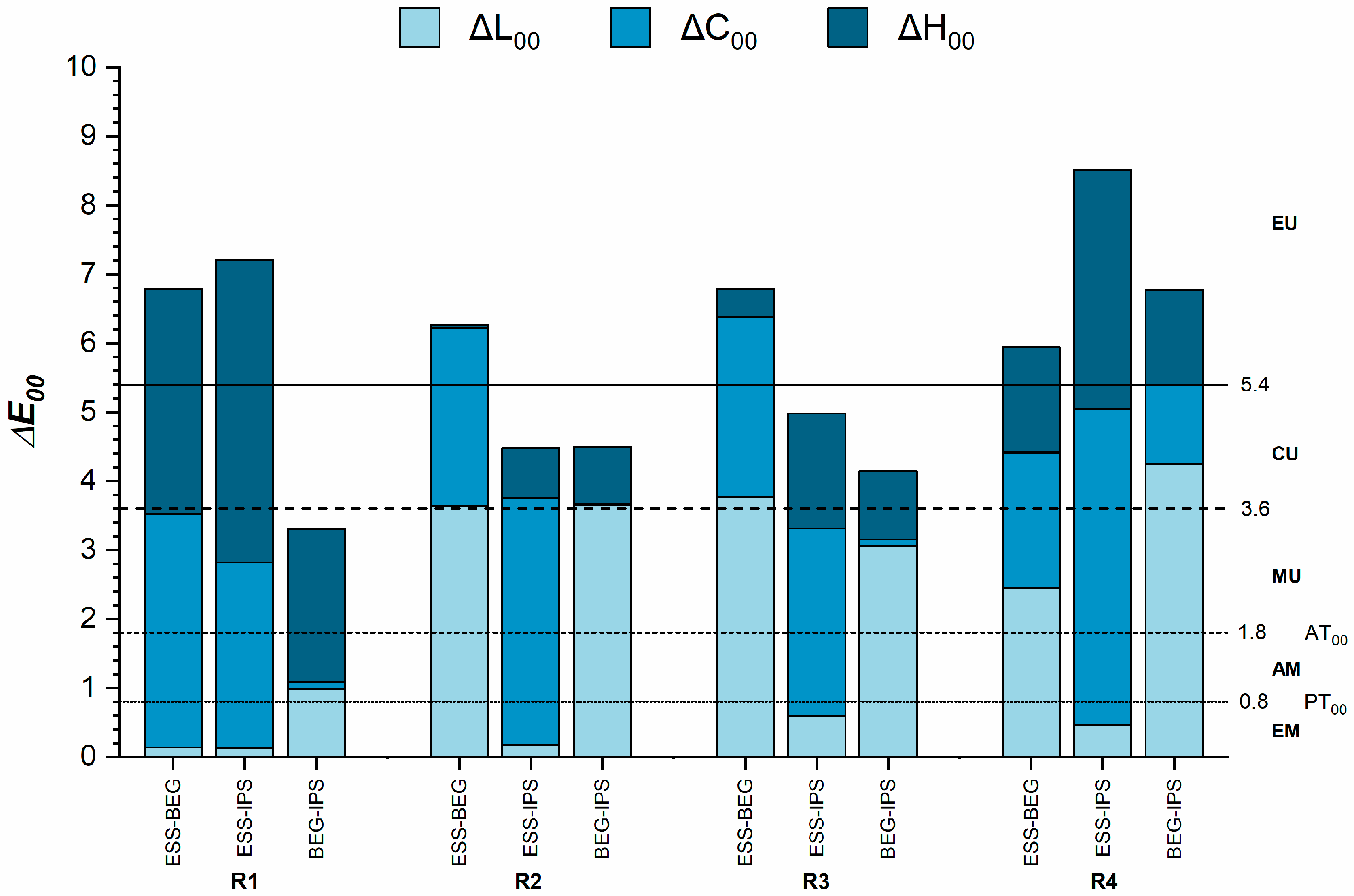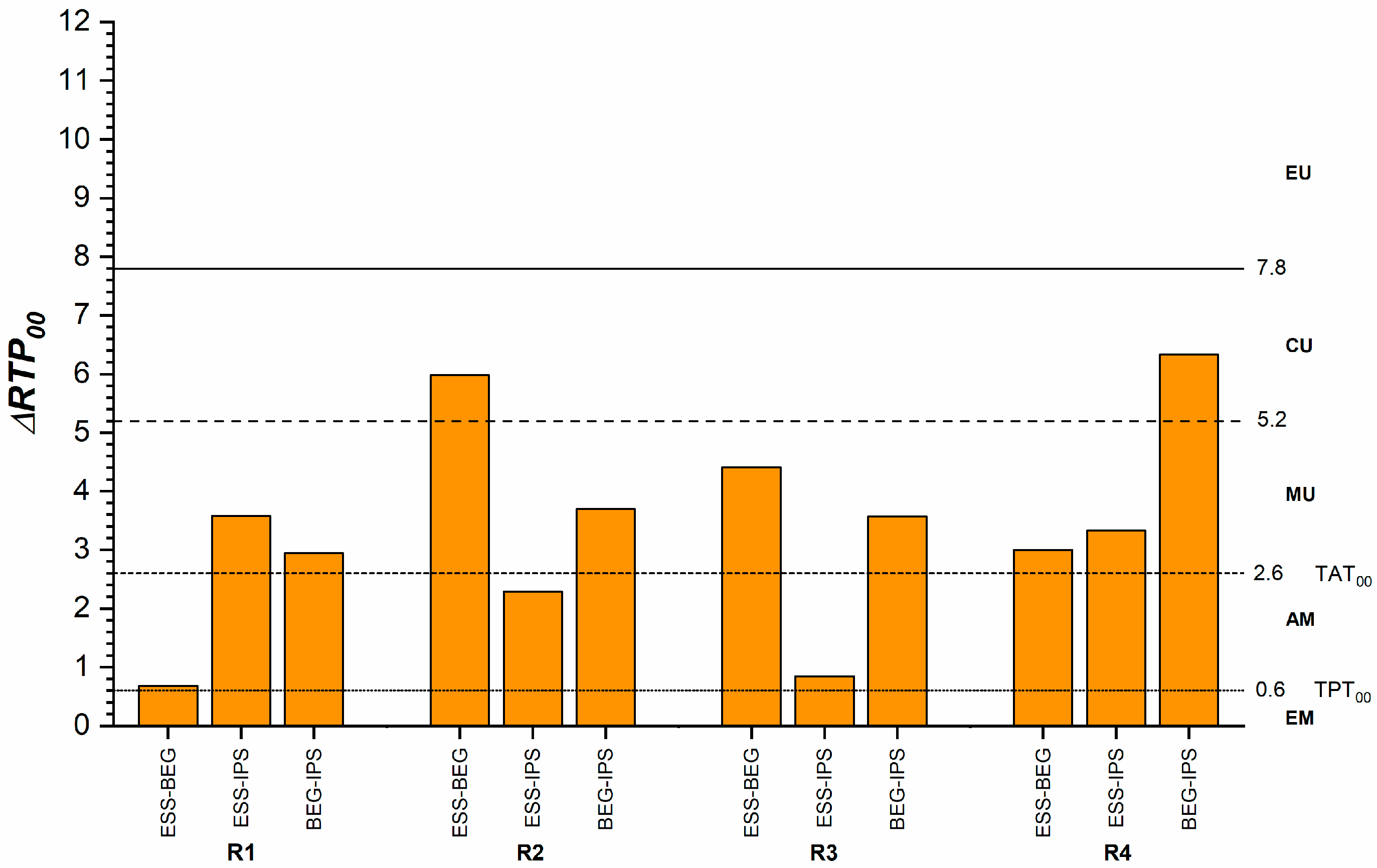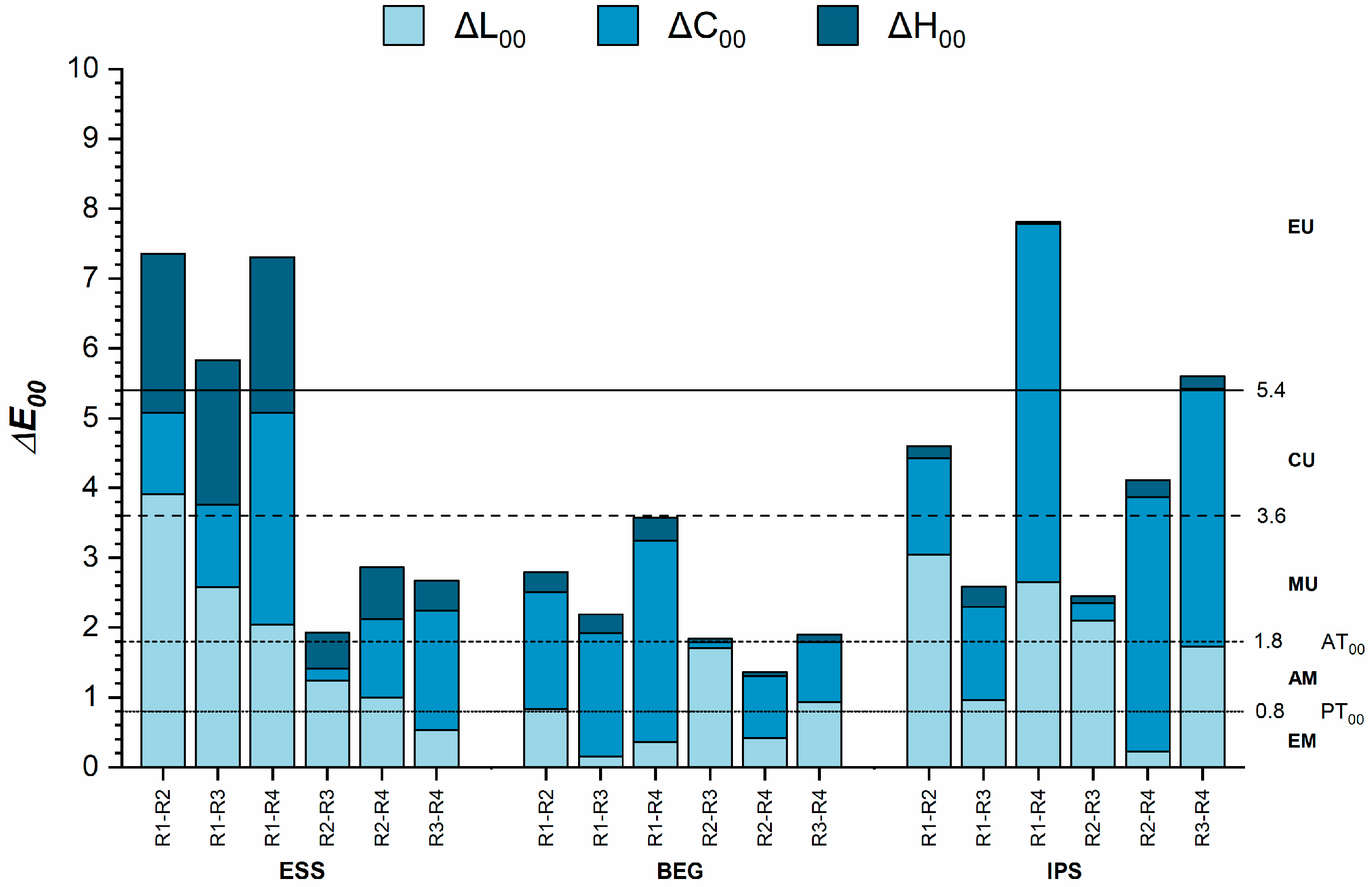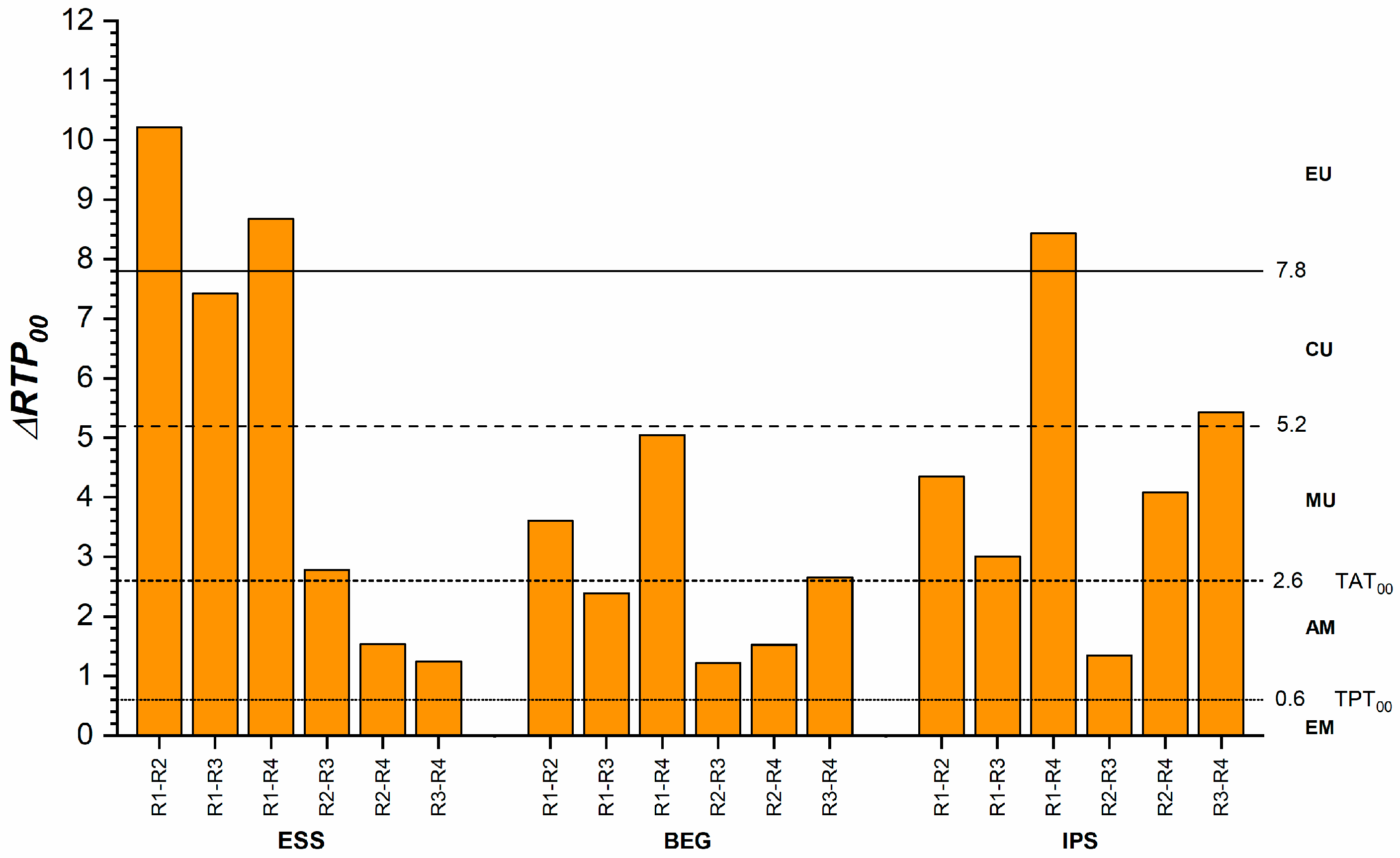Color and Translucency Compatibility Among Various Resin-Based Composites and Layering Strategies
Abstract
1. Introduction
2. Materials and Methods
2.1. Material Selection and Sample Preparation
2.2. Color Measurement and Calculation
2.3. Statistical Analysis
3. Results
3.1. Comparison of the Same Layering Recipes Across Different Materials
3.2. Comparison of the Different Layering Recipes Within the Same Materials
4. Discussion
5. Conclusions
Author Contributions
Funding
Institutional Review Board Statement
Informed Consent Statement
Data Availability Statement
Conflicts of Interest
References
- Vargas, M.; Saisho, H.; Maharishi, A.; Margeas, R. A practical, predictable, and reliable method to select shades for direct resin composite restorations. J. Esthet. Restor. Dent. 2023, 35, 19–25. [Google Scholar] [CrossRef] [PubMed]
- Kobayashi, S.; Nakajima, M.; Furusawa, K.; Tichy, A.; Hosaka, K.; Tagami, J. Color adjustment potential of single-shade resin composite to various-shade human teeth: Effect of structural color phenomenon. Dent. Mater. J. 2021, 40, 1033–1040. [Google Scholar] [CrossRef] [PubMed]
- Ricci, W.A.; Fahl, N., Jr. Nature-mimicking layering with composite resins through a bio-inspired analysis: 25 years of the polychromatic technique. J. Esthet. Restor. Dent. 2023, 35, 7–18. [Google Scholar] [CrossRef] [PubMed]
- Hirata, R.; de Abreu, J.L.; Benalcázar-Jalkh, E.B.; Atria, P.; Cascales, Á.F.; Cantero, J.S.; Sampaio, C.S. Analysis of translucency parameter and fluorescence intensity of 5 resin composite systems. J. Clin. Exp. Dent. 2024, 16, e71–e77. [Google Scholar] [CrossRef]
- Lee, Y.K.; Yu, B.; Zhao, G.F.; Lim, J.I. Color assimilation of resin composites with adjacent color according to the distance. J. Esthet. Restor. Dent. 2015, 27 (Suppl. 1), S24–S32. [Google Scholar] [CrossRef]
- Lee, Y.-K. Translucency of human teeth and dental restorative materials and its clinical relevance. J. Biomed. Opt. 2015, 20, 045002. [Google Scholar] [CrossRef]
- Lee, Y.K. Influence of scattering/absorption characteristics on the color of resin composites. Dent. Mater. 2007, 23, 124–131. [Google Scholar] [CrossRef]
- Arikawa, H.; Fujii, K.; Kanie, T.; Inoue, K. Light transmittance characteristics of light-cured composite resins. Dent. Mater. 1998, 14, 405–411. [Google Scholar] [CrossRef]
- Islam, M.S.; Huda, N.; Mahendran, S.; Aryal Ac, S.; Nassar, M.; Rahman, M.M. The Blending Effect of Single-Shade Composite with Different Shades of Conventional Resin Composites-An In Vitro Study. Eur. J. Dent. 2023, 17, 342–348. [Google Scholar] [CrossRef]
- Gurgan, S.; Koc Vural, U.; Miletic, I. Comparison of mechanical and optical properties of a newly marketed universal composite resin with contemporary universal composite resins: An in vitro study. Microsc. Res. Tech. 2022, 85, 1171–1179. [Google Scholar] [CrossRef]
- The International Commission on Illumination. CIE 015:2018 Colorimetry, 4th ed.; CIE Central Bureau: Vienna, Austria, 2018. [Google Scholar]
- Paravina, R.D.; Pérez, M.M.; Ghinea, R. Acceptability and perceptibility thresholds in dentistry: A comprehensive review of clinical and research applications. J. Esthet. Restor. Dent. 2019, 31, 103–112. [Google Scholar] [CrossRef] [PubMed]
- Paravina, R.D.; Ghinea, R.; Herrera, L.J.; Bona, A.D.; Igiel, C.; Linninger, M.; Sakai, M.; Takahashi, H.; Tashkandi, E.; Perez Mdel, M. Color difference thresholds in dentistry. J. Esthet. Restor. Dent. 2015, 27 (Suppl. 1), S1–S9. [Google Scholar] [CrossRef] [PubMed]
- Akl, M.A.; Sim, C.P.C.; Nunn, M.E.; Zeng, L.L.; Hamza, T.A.; Wee, A.G. Validation of two clinical color measuring instruments for use in dental research. J. Dent. 2022, 125, 104223. [Google Scholar] [CrossRef] [PubMed]
- Tsiliagkou, A.; Diamantopoulou, S.; Papazoglou, E.; Kakaboura, A. Evaluation of reliability and validity of three dental color-matching devices. Int. J. Esthet. Dent. 2016, 11, 110–124. [Google Scholar]
- Kim-Pusateri, S.; Brewer, J.D.; Davis, E.L.; Wee, A.G. Reliability and accuracy of four dental shade-matching devices. J. Prosthet. Dent. 2009, 101, 193–199. [Google Scholar] [CrossRef]
- Lee, Y.K. Criteria for clinical translucency evaluation of direct esthetic restorative materials. Restor. Dent. Endod. 2016, 41, 159–166. [Google Scholar] [CrossRef]
- Villarroel, M.; Fahl, N.; De Sousa, A.M.; De Oliveira, O.B., Jr. Direct esthetic restorations based on translucency and opacity of composite resins. J. Esthet. Restor. Dent. 2011, 23, 73–87. [Google Scholar] [CrossRef]
- Johnston, W.M.; Ma, T.; Kienle, B.H. Translucency parameter of colorants for maxillofacial prostheses. Int. J. Prosthodont. 1995, 8, 79–86. [Google Scholar]
- Pecho, O.E.; Benetti, P.; Ruiz-López, J.; Furini, G.P.; Tejada-Casado, M.; Pérez, M.M. Optical properties of dental zirconia, bovine dentin, and enamel-dentin structures. J. Esthet. Restor. Dent. 2024, 36, 511–519. [Google Scholar] [CrossRef]
- Salas, M.; Lucena, C.; Herrera, L.J.; Yebra, A.; Della Bona, A.; Pérez, M.M. Translucency thresholds for dental materials. Dent. Mater. 2018, 34, 1168–1174. [Google Scholar] [CrossRef]
- Dietschi, D.; Ardu, S.; Krejci, I. A new shading concept based on natural tooth color applied to direct composite restorations. Quintessence Int. 2006, 37, 91–102. [Google Scholar]
- Paravina, R.D.; Kimura, M.; Powers, J.M. Color compatibility of resin composites of identical shade designation. Quintessence Int. 2006, 37, 713–719. [Google Scholar] [PubMed]
- Browning, W.D.; Contreras-Bulnes, R.; Brackett, M.G.; Brackett, W.W. Color differences: Polymerized composite and corresponding Vitapan Classical shade tab. J. Dent. 2009, 37 (Suppl. 1), e34–e39. [Google Scholar] [CrossRef] [PubMed]
- Morel, L.L.; de Holanda, G.A.; Perroni, A.P.; de Moraes, R.R.; Boscato, N. Effect of shade and opacity on color differences and translucency of resin composite veneers over lighter and darker substrates. Odontology 2024, 112, 355–363. [Google Scholar] [CrossRef]
- Vanini, L. Conservative Composite Restorations that Mimic Nature. J. Cosmet. Dent. 2010, 26, 80–98. [Google Scholar]
- Bazos, P.; Magne, P. Bio-Emulation: Biomimetically emulating nature utilizing a histoanatomic approach; visual synthesis. Int. J. Esthet. Dent. 2014, 9, 330–352. [Google Scholar]
- Dietschi, D.; Fahl, N., Jr. Shading concepts and layering techniques to master direct anterior composite restorations: An update. Br. Dent. J. 2016, 221, 765–771. [Google Scholar] [CrossRef]
- Manauta, J.; Salat, A.; Putignano, A.; Devoto, W.; Paolone, G.; Hardan, L.S. Stratification in anterior teeth using one dentine shade and a predefined thickness of enamel: A new concept in composite layering—Part I. Odontostomatol. Trop. 2014, 37, 5–16. [Google Scholar]
- Manauta, J.; Salat, A.; Putignano, A.; Devoto, W.; Paolone, G.; Hardan, L.S. Stratification in anterior teeth using one dentine shade and a predefined thickness of enamel: A new concept in composite layering—Part II. Odontostomatol. Trop. 2014, 37, 5–13. [Google Scholar]
- Balci, M.; Ergucu, Z.; Çelik, E.U.; Turkun, L.S. Comparison between translucencies of anterior resin composites and natural dental tissues. Color Res. Appl. 2021, 46, 635–644. [Google Scholar] [CrossRef]
- Kim, S.J.; Son, H.H.; Cho, B.H.; Lee, I.B.; Um, C.M. Translucency and masking ability of various opaque-shade composite resins. J. Dent. 2009, 37, 102–107. [Google Scholar] [CrossRef] [PubMed]
- Naeimi Akbar, H.; Moharamzadeh, K.; Wood, D.J.; Van Noort, R. Relationship between Color and Translucency of Multishaded Dental Composite Resins. Int. J. Dent. 2012, 2012, 708032. [Google Scholar] [CrossRef] [PubMed][Green Version]
- Paolone, G. Direct composites in anteriors: A matter of substrate. Int. J. Esthet. Dent. 2017, 12, 468–481. [Google Scholar]
- Khashayar, G.; Dozic, A.; Kleverlaan, C.J.; Feilzer, A.J.; Roeters, J. The influence of varying layer thicknesses on the color predictability of two different composite layering concepts. Dent. Mater. 2014, 30, 493–498. [Google Scholar] [CrossRef]
- Betrisey, E.; Krejci, I.; Di Bella, E.; Ardu, S. The influence of stratification on color and appearance of resin composites. Odontology 2016, 104, 176–183. [Google Scholar] [CrossRef]
- Gueli, A.M.; Pedullà, E.; Pasquale, S.; La Rosa, G.R.; Rapisarda, E. Color specification of two new resin composites and influence of stratification on their chromatic perception. Color Res. Appl. 2017, 42, 684–692. [Google Scholar] [CrossRef]
- La Rosa, G.R.M.; Pasquale, S.; Pedullà, E.; Palermo, F.; Rapisarda, E.; Gueli, A.M. Colorimetric study about the stratification’s effect on colour perception of resin composites. Odontology 2020, 108, 479–485. [Google Scholar] [CrossRef]
- Diamantopoulou, S.; Johnston, W.M.; Ghinea, R.; Papazoglou, E. Coverage error of three resin composite systems to vital unrestored maxillary anterior teeth. J. Esthet. Restor. Dent. 2023, 35, 352–359. [Google Scholar] [CrossRef]
- Korkut, B.; Dokumacigil, G.; Murat, N.; Atali, P.Y.; Tarcin, B.; Gocmen, G.B. Effect of Polymerization on the Color of Resin Composites. Oper. Dent. 2022, 47, 514–526. [Google Scholar] [CrossRef]
- Dalmolin, A.; Perez, B.G.; Gaidarji, B.; Ruiz-López, J.; Lehr, R.M.; Pérez, M.M.; Durand, L.B. Masking ability of bleach-shade resin composites using the multilayering technique. J. Esthet. Restor. Dent. 2021, 33, 807–814. [Google Scholar] [CrossRef]
- Perez, B.G.; Gaidarji, B.; Palm, B.G.; Ruiz-López, J.; Pérez, M.M.; Durand, L.B. Masking ability of resin composites: Effect of the layering strategy and substrate color. J. Esthet. Restor. Dent. 2022, 34, 1206–1212. [Google Scholar] [CrossRef] [PubMed]
- Nogueira, A.D.; Della Bona, A. The effect of a coupling medium on color and translucency of CAD-CAM ceramics. J. Dent. 2013, 41 (Suppl. 3), e18–e23. [Google Scholar] [CrossRef] [PubMed]
- Luo, M.R.; Cui, G.; Rigg, B. The Development of the CIE 2000 Colour-Difference Formula: CIEDE2000. Color. Res. Appl. 2001, 26, 340–350. [Google Scholar] [CrossRef]
- ISO/TR 28642; Dentistry—Guidance on Colour Measurement. ISO: Geneva, Switzerland, 2016.
- Nobbs, J.H. A Lightness, Chroma and Hue Splitting Approach to CIEDE2000 Colour Differences. Adv. Colour Sci. Technol. 2002, 5, 46–53. [Google Scholar]
- Paravina, R.D.; Cevik, P.; Ontiveros, J.C.; Johnston, W.M. Translucency of Enamel and Dentin: A Biomimetic Target for Esthetic Dental Materials. J. Esthet. Restor. Dent. 2025. [Google Scholar] [CrossRef]
- Oivanen, M.; Keulemans, F.; Garoushi, S.; Vallittu, P.K.; Lassila, L. The effect of refractive index of fillers and polymer matrix on translucency and color matching of dental resin composite. Biomater. Investig. Dent. 2021, 8, 48–53. [Google Scholar] [CrossRef]
- Coltene. Brilliant Ever Glow. Available online: https://coltene.dental/clinician-special/brilliant-everglow/ (accessed on 5 March 2025).
- Kim, D.; Park, S.H. Color and Translucency of Resin-based Composites: Comparison of A-shade Specimens Within Various Product Lines. Oper. Dent. 2018, 43, 642–655. [Google Scholar] [CrossRef]
- Vichi, A.; Fraioli, A.; Davidson, C.L.; Ferrari, M. Influence of thickness on color in multi-layering technique. Dent. Mater. 2007, 23, 1584–1589. [Google Scholar] [CrossRef]
- Ismail, E.H. Color interaction between resin composite layers: An overview. J. Esthet. Restor. Dent. 2021, 33, 1105–1117. [Google Scholar] [CrossRef]





| Material/Shade Designation/Codification | Type | Shade/Opacity | Composition | Batch Number |
|---|---|---|---|---|
| Essentia (GC, Tokyo, Japan) Group-shade Non-VITA shade designation Codification: ESS | Microhybrid | LE (light enamel) | Matrix: UDMA, Bis-MEPP, Bis-EMA, Bis-GMA, TEGDMA Filler: Pre-polymerized fillers (10 nm), barium glass (300 nm), fumed silica (16 nm), 81 wt% (65%) | 180130A |
| LD (light dentin) | Matrix: UDMA, Bis-MEPP, Bis-EMA, Bis-GMA, TEGDMA Prepolymerised fillers (17 μm): strontium glass (400 nm), barium glass (300 nm), lanthanide flüoride (100 nm), fumed silica (16 nm) FAISi glass (850 nm), 76–81 wt % | 170905A | ||
| ML (masking liner) | UDMA (10–25%), homogeneously dispersed ultra-fine fillers titanium dioxide (0.5–1%), silane, reaction products with silica (0.5–1%), diphenyl (2,4,6-trimethylbenzoyl) phosphine oxide (0.5–1%) SiO2: Diameter particle structure = 2.5–50 nm Diameter agglomerate = 5–50 mm | 170816A | ||
| Brilliant Ever Glow (Coltene) Group-shade VITA shade designation Codification: BEG | Universal submicron hybrid composite | Translucent | Not available | I36341 |
| A1/B1 | Matrix: Bis-GMA (1–5 wt%), Bis-EMA (10–15 wt%), TEGDMA (1–5 wt%) Fillers: zinc oxide (<1.5%), ytterbium trifluoride (<10%), (submicron) barium glass fillers, dental glass and nanosilica; pre-polymerised fillers, filler content by weight 79%; filler content by volume 64%, inorganic filler size 20–1500 nm | H27017 | ||
| OA1 | Not available | I37878 | ||
| IPS Empress Direct (Ivoclar Vivadent, Schaan, Lichtenstein) Multishade VITA shade designation Codification: IPS | Nanohybrid | A1E (enamel, shade A1) | Matrix: UDMA (10–25%), TCDDA (2.5–10%) Fillers:Ba-Al-fluorosilicate glass, barium glass filler, mixed oxide ytterbium trifluoride, prepolymer, mixed oxide and glass particles 75–79 wt%, 52–59 vol | W95078 |
| A1D (dentin, shade A1) | Monomers: Bis-GMA, UDMA (10–25%), and TCDDA (2.5–10%) Fillers: Ba-Al-fluorosilicate glass (50.2 wt%), ytterbium trifluoride (9.8 wt%), mixed oxide, prepolymer (19.6 wt%) | Y07490 | ||
| Opaque | Matrix: UDMA (10–25%), DDDMA (10–25%) Dimethacrylates (53.9 wt. %) Fillers: Barium glass, ytterbium trifluoride (2.5–10%), Al-fluorosilicate glass, spheroid mixed oxide (43.4 wt %). Total content of inorganic fillers (23.2 vol %). Particle size 0.04–3.0 μm, mean particle size: 0.7 μm | W98712 |
| Recipes | ESS | BEG | IPS |
|---|---|---|---|
| R1 | 1 mm LE | 1 mm T | 1 mm A1 E |
| R2 | 1 mm LD | 1 mm A1/B1 | 1 mm A1 D |
| R3 | 0.5 mm LD + LE | 0.5 mm A1/B1 + 0.5 mm T | 0.5 mm A1 D + 0.5 mm A1 E |
| R4 | 0.25 mm ML + 0.25 mm LD + 0.5 mm LE | 0.25 mm OA1 + 0.25 mm A1/B1 + 0.5 mm T | 0.25 mm Opaque + 0.25 mm A1D + 0.5 mm A1E |
| Material | Recipe | L* | a* | b* | C* | h° | RTP00 |
|---|---|---|---|---|---|---|---|
| ESS | R1 | 68.06 (0.30) | −1.55 (0.39) bE | 0.03 (0.19) | 1.56 (0.40) | 178.30 (6.40) | 19.19 (0.36) |
| R2 | 75.12 (0.54) | −0.92 (0.20) C | 5.53 (0.31) | 5.61 (0.32) | 99.41 (1.96) | 8.98 (0.25) | |
| R3 | 73.09 (0.92) A | −1.45 (0.43) aCE | 4.79 (0.15) | 5.02 (0.20) | 106.72 (4.62)A | 11.76 (0.28) | |
| R4 | 72.93 (1.58) A | −2.41 (1.09) cE | 7.03 (0.21) | 7.49 (0.49) | 108.50 (7.48) A | 10.52 (0.52) | |
| BEG | R1 | 66.99 (0.49) C | −1.49 (0.35) bD | 7.88 (0.39) b | 8.03 (0.36) b | 100.73 (2.73) BC | 18.56 (0.36) |
| R2 | 68.81 (0.64) B | −1.44 (0.05) D | 11.07 (0.46) aA | 11.16 (0.46) aA | 97.45 (0.50) BC | 14.96 (0.56) | |
| R3 | 66.58 (0.32) C | −1.55 (0.13) aD | 10.77 (0.36) A | 10.88 (0.35) A | 98.22 (0.83) B | 16.17 (0.38) | |
| R4 | 68.17 (0.74) B | −1.50 (0.12) cD | 12.74 (0.37) | 12.83 (0.36) | 96.70 (0.65) C | 13.52 (0.92) | |
| IPS | R1 | 69.20 (0.18) | 0.48 (0.15) A | 7.63 (0.43) b | 7.65 (0.44) b | 86.43 (0.95) E | 15.61 (0.35) |
| R2 | 74.13 (0.55) | −0.01 (0.30) B | 11.21 (0.36) a | 11.21 (0.36) a | 90.29 (0.93) D | 11.27 (0.22) | |
| R3 | 71.12 (0.89) | −0.02 (0.27) B | 10.20 (0.22) | 10.21 (0.23) | 90.08 (1.51) D | 12.61 (0.21) | |
| R4 | 75.24 (0.70) | 0.85 (0.37) A | 17.54 (0.84) | 17.56 (0.85) | 87.25 (1.14) E | 7.18 (0.73) |
Disclaimer/Publisher’s Note: The statements, opinions and data contained in all publications are solely those of the individual author(s) and contributor(s) and not of MDPI and/or the editor(s). MDPI and/or the editor(s) disclaim responsibility for any injury to people or property resulting from any ideas, methods, instructions or products referred to in the content. |
© 2025 by the authors. Licensee MDPI, Basel, Switzerland. This article is an open access article distributed under the terms and conditions of the Creative Commons Attribution (CC BY) license (https://creativecommons.org/licenses/by/4.0/).
Share and Cite
Varvara, E.B.; Gasparik, C.; Ruiz-López, J.; Aghiorghiesei, A.I.; Culic, B.; Dudea, D. Color and Translucency Compatibility Among Various Resin-Based Composites and Layering Strategies. Dent. J. 2025, 13, 173. https://doi.org/10.3390/dj13040173
Varvara EB, Gasparik C, Ruiz-López J, Aghiorghiesei AI, Culic B, Dudea D. Color and Translucency Compatibility Among Various Resin-Based Composites and Layering Strategies. Dentistry Journal. 2025; 13(4):173. https://doi.org/10.3390/dj13040173
Chicago/Turabian StyleVarvara, Elena Bianca, Cristina Gasparik, Javier Ruiz-López, Alexandra Iulia Aghiorghiesei, Bogdan Culic, and Diana Dudea. 2025. "Color and Translucency Compatibility Among Various Resin-Based Composites and Layering Strategies" Dentistry Journal 13, no. 4: 173. https://doi.org/10.3390/dj13040173
APA StyleVarvara, E. B., Gasparik, C., Ruiz-López, J., Aghiorghiesei, A. I., Culic, B., & Dudea, D. (2025). Color and Translucency Compatibility Among Various Resin-Based Composites and Layering Strategies. Dentistry Journal, 13(4), 173. https://doi.org/10.3390/dj13040173








